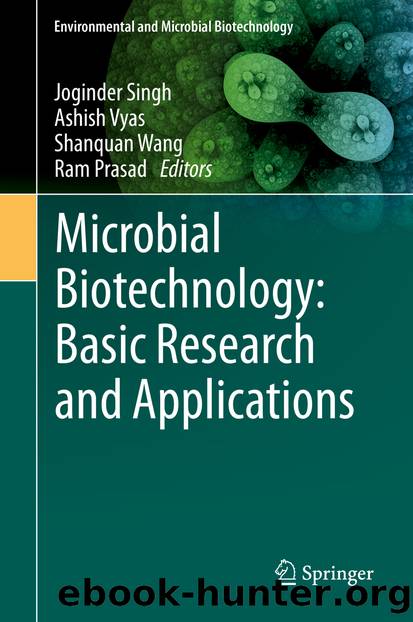Microbial Biotechnology: Basic Research and Applications by Unknown

Author:Unknown
Language: eng
Format: epub
ISBN: 9789811528170
Publisher: Springer Singapore
7.9 Applications of Nanoparticles for Wastewater Treatment
7.9.1 Typical Composition of Wastewaters
Before moving on to the mechanisms and efficacies of nanoparticle-enabled wastewater treatment technology, it is quite logical to know about the chemical diversity of wastewater streams in terms of its composition. Multiple research attempts on wastewater streams from different regions of the globe list six major deleterious components, namely, suspended solids, biodegradable organics, pathogens, nutrients, heavy metals, and soluble inorganic salts (Abdel-Raouf et al. 2012). All these constituents pose a significant risk to the pollution level of wastewaters and could be present either in native form or added at various stages of domestic water discharge. For example, the nutrients carbohydrates, fats, and proteins could be present from the source itself (may be due to excretion products of humans and animals), whereas heavy metals could be added to the wastewater stream if it has access to industries. Similarly, the organic constituents act as existence support towards the environmental microbial species, which continuously grow, propagate, and increase their metabolic activities while residing on it (Lareen et al. 2016). Consequently, the microbial load increases, and with waste material as dietary input, these organisms exhibit toxic responses and are easily the opportunistic carriers of communicable infections (Figs. 7.7 and 7.8).
Fig. 7.7Major polluting constituents in a wastewater stream
Download
This site does not store any files on its server. We only index and link to content provided by other sites. Please contact the content providers to delete copyright contents if any and email us, we'll remove relevant links or contents immediately.
| Automotive | Engineering |
| Transportation |
Whiskies Galore by Ian Buxton(41879)
Introduction to Aircraft Design (Cambridge Aerospace Series) by John P. Fielding(33064)
Small Unmanned Fixed-wing Aircraft Design by Andrew J. Keane Andras Sobester James P. Scanlan & András Sóbester & James P. Scanlan(32743)
Craft Beer for the Homebrewer by Michael Agnew(18140)
Turbulence by E. J. Noyes(7936)
The Complete Stick Figure Physics Tutorials by Allen Sarah(7307)
Kaplan MCAT General Chemistry Review by Kaplan(6866)
The Thirst by Nesbo Jo(6826)
Bad Blood by John Carreyrou(6552)
Modelling of Convective Heat and Mass Transfer in Rotating Flows by Igor V. Shevchuk(6391)
Learning SQL by Alan Beaulieu(6209)
Weapons of Math Destruction by Cathy O'Neil(6143)
Man-made Catastrophes and Risk Information Concealment by Dmitry Chernov & Didier Sornette(5921)
Digital Minimalism by Cal Newport;(5664)
Life 3.0: Being Human in the Age of Artificial Intelligence by Tegmark Max(5474)
iGen by Jean M. Twenge(5366)
Secrets of Antigravity Propulsion: Tesla, UFOs, and Classified Aerospace Technology by Ph.D. Paul A. Laviolette(5309)
Design of Trajectory Optimization Approach for Space Maneuver Vehicle Skip Entry Problems by Runqi Chai & Al Savvaris & Antonios Tsourdos & Senchun Chai(5011)
Pale Blue Dot by Carl Sagan(4912)
